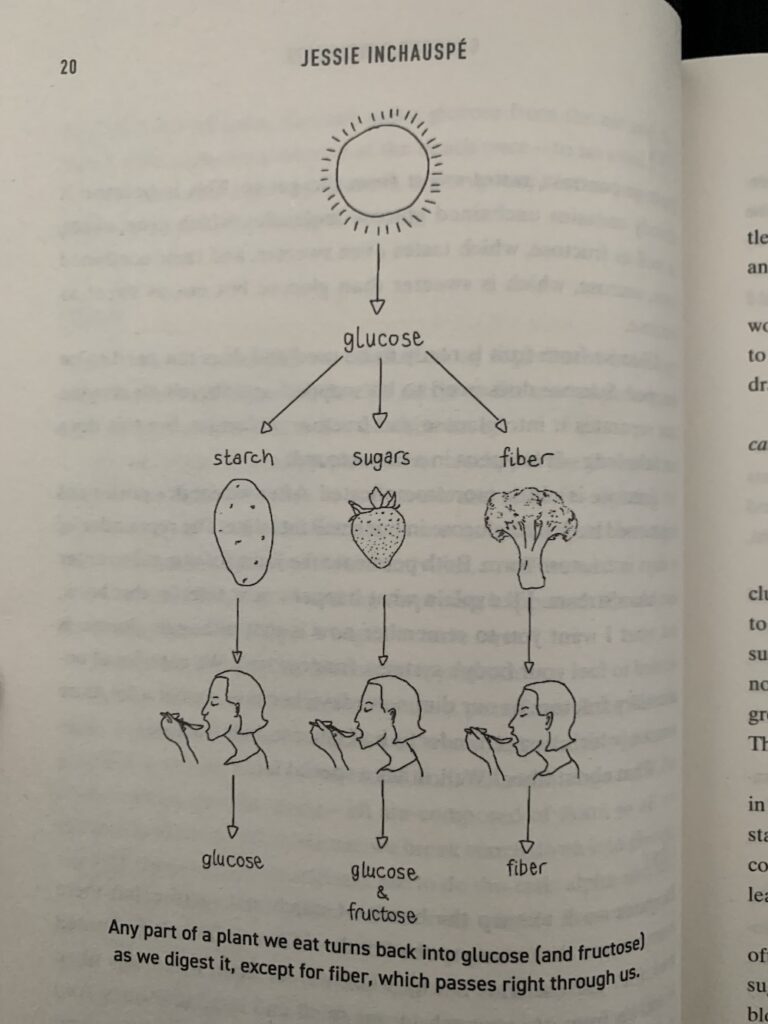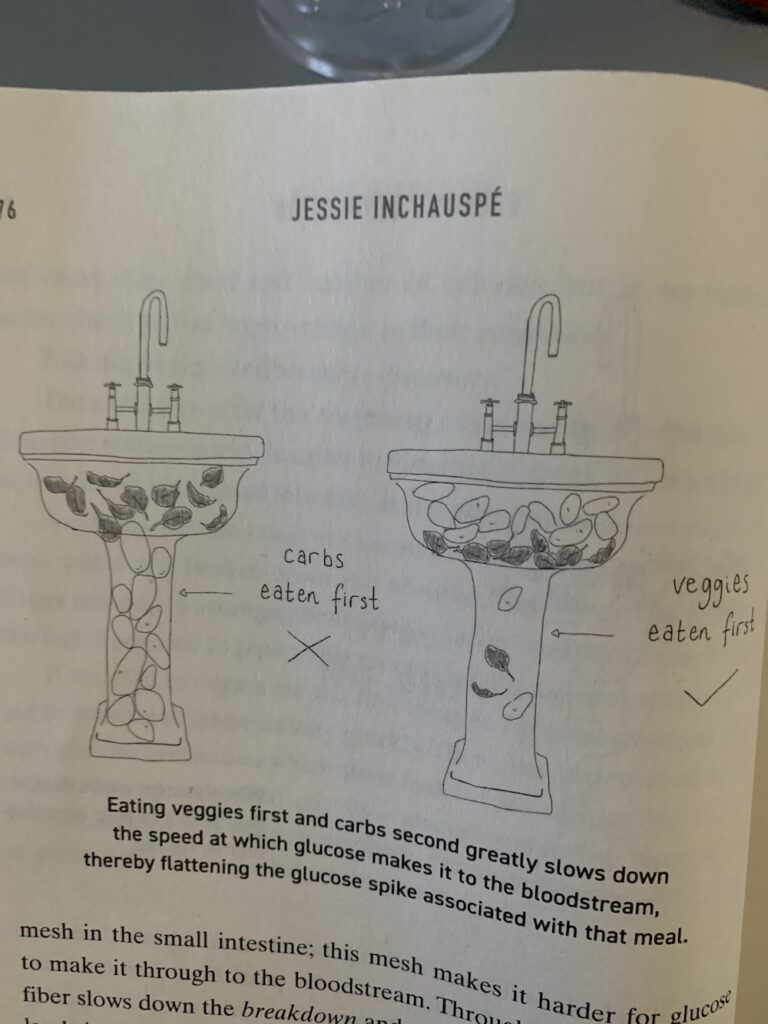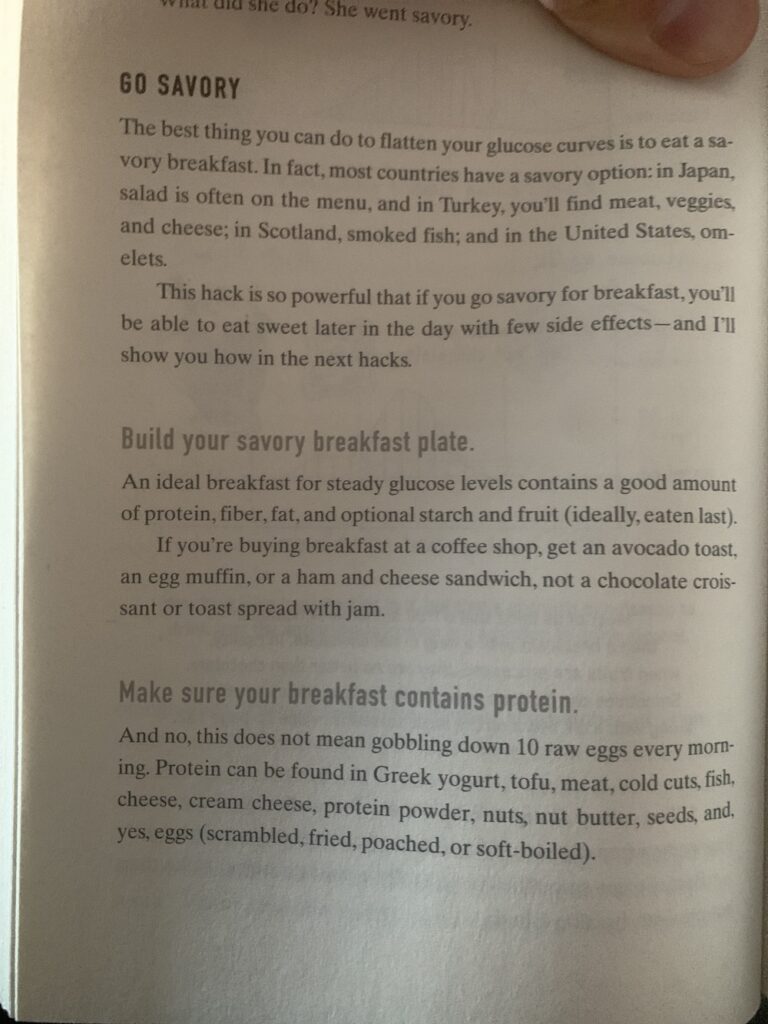
Book: Glucose Revolution
Improve all areas of your health—your sleep, cravings, mood, energy, skin, weight—and even slow down aging with easy, science-based hacks to manage your blood sugar while still eating the foods you love.
Glucose, or blood sugar, is a tiny molecule in our body that has a huge impact on our health. It enters our bloodstream through the starchy or sweet foods we eat. Ninety percent of us suffer from too much glucose in our system—and most of us don’t know it.
The symptoms? Cravings, fatigue, infertility, hormonal issues, acne, wrinkles… And over time, the development of conditions like type 2 diabetes, polycystic ovarian syndrome, cancer, dementia, and heart disease.
Drawing on cutting-edge science and her own pioneering research, biochemist Jessie Inchauspé offers ten simple, surprising hacks to help you balance your glucose levels and reverse your symptoms—without going on a diet or giving up the foods you love. For example:
* How eating foods in the right order will make you lose weight effortlessly
* What secret ingredient will allow you to eat dessert and still go into fat-burning mode
* What small change to your breakfast will unlock energy and cut your cravings
Both entertaining, informative, and packed with the latest scientific data, this book presents a new way to think about better health. Glucose Revolution is chock-full of tips that can drastically and immediately improve your life, whatever your dietary preferences.
Rating (1-10) –
Book Review –
Notes:
Part 1: The Power of Mimetic Desire
Chapter 1: What is GlucoseGlucose is one of the most important levers we can control that will affect t so many aspects of our lives.
Glucose is one of the most important levers we can control that will affect t so many aspects of our lives.
Chapter 2: Meet Jerry
- Plants take carbon dioxide and water to form glucose.
- Glucose is the little building block that makes up plants.
- Glucose from plants can be turned into different substances from the help of different types of enzymes.
- Starch is glucose chained together by an enzyme used to store energy. When energy is needed another enzyme called alpha-amylase is used to break off some glucose from the glucose chain.
- Fiber is made from glucose as well through another type of enzyme.
- Fructose is also made from glucose. A fructose molecule is 2.3 times sweeter than glucose. It’s what is used to make fruit which animals eat and propagate a trees seed.
- Sucrose if formed when fructose and glucose combine for a time which allows for a plant to store more energy.
Chapter 3: A Family Affair
- Starch is in all bread because it comes from grinding wheat and wheat is filled with starch
- Once it’s in our system, our body uses alpha-amylase to break apart starch to turn it into glucose so our body can use it for energy.
- The enzyme also exists in our saliva so when we chew bread, it starts tasting sweet if we don’t swallow our bread too early.
- Fruit is sweet from the get go because it has unchained glucose. It also has fructose and sucrose.
- Fiber has no enzyme in our body to break it down into glucose which helps us with our digestion, maintains healthy bowel movement, and keeps our micro biome healthy.

- Carbohydrates are the family of foods that come from glucose. It’s called carbohydrates because glucose is made from carbon and hydrogen.
- Our bodies don’t need to each glucose in our to have it in our system. Our bodies can make it from carbon and hydrogen but it can make it from other foods we eat like protein. Our bodies have learned to adapt. It’s called metabolic flexibility.
- If our bodies don’t have glucose available it can also use fat as a source of energy. A keto diet tries to get our body to consume fat in a process called nutritional ketosis.
Chapter 4: Seeking Pleasure
- There are no foods that are both sweet and poisonous. We love sweets because prehistorically humans gravitated towards sweets because sweet fruit meant it wasn’t poisonous.
- Dopamine floods our system when we have sugar
Chapter 5: Underneath Our Skin
- The goal is to flatten your glucose spike variability.
- Eating sugary foods vs. starchy foods will have a similar glucose spike but sugary foods are worse because we also get a fructose spike that we can’t measure yet.
Part 2: Why are Glucose Spikes Harmful
Chapter 6: Trains, Toast, and Tetris
- Mitochondria turns glucose into energy in our cells
- Mitochondria can only burn what it needs for energy
- Too much glucose too quickly is the problem. Our mitochondria can’t turn it into energy fast enough
- When cells are given too much glucose and our mitochondria can’t keep up, it produces something called free radicals that is dangerous for our bodies
- Free radicals are dangerous because anything it touches damages. It also alters our genetic code.
- Oxidative stress is when free radicals are attacking our cells. Too much damage and it leads to things like diabetes, heart disease, cognitive decline and aging.
- Fructose increases oxidative stress
- Too much fat also causes oxidative stress.
- When glucose molecules bump into other molecules it’s said the other molecule is glycated. It means it’s getting damaged and it’s normal in the aging process. It’s why our organs deteriorate, we get old, etc. We can’t stop the process but we can slow it down.
- The more glucose we introduce to our cells the more glycation happens. Once a molecule is damaged it’s damaged forever.
- Glycation is like browning of bread. It’s how our bodies age. If you slow down the browning you slow down the agin.
- Fructose glycates things 10 times faster than glucose
- The combination of glycation, free radicals, and oxidative stress leads to inflammation. Inflammation is a protective mechanism of your body but when there is too much inflammation your body starts deteriorating.
- Chronic inflammation is the source of most chronic illnesses.
- Our pancreas creates something called insulin to help store and transport extra glucose into different parts of our body. It transfers glucose to our liver which turns glucose into glycogen. Similar to what a plant does turning glucose into starch. Glycogen and starch are cousins. Once glucose is in glycogen form, it doesn’t do damage. No glycation.
- After the liver, insulin transports glucose to our muscles and then fat deposits.
- Fructose can’t be turned into glycogen so it can only be stored as fat
- If you had a choice, choose the food without the sugary taste of fructose. They end up as fat. Too much fat and it gets send to our liver, it ends up in our fat cells which make us fat.
Chapter 7: From Head to Toe
- Glucose spikes which leads to diabetes also influence the chances of getting Alzheimer’s. It’s even called type 3 diabetes because our brains use a lot of energy. That means our brain cells use our mitochondria to turn into energy. Too much glucose and our cells can’t keep up which means our brains are susceptible to free radicals and oxidation.
- Glucose spikes are the cause for so many issues in our health from aging faster, diabetes, cancer etc.
Part 3: How Can I Flatten My Glucose Curves
Hack 1: Eat foods in the right order
- The proper order to eat your food is fibers, proteins and fats, starch and then sugary foods

Hack 2: Add a green starter to all your meals
- Add a fibrous add on to all your meals. Beans, leafy greens, and veggies
Hack 3: Stop Counting Calories
- Calories measures heat produced
- Anything can have a caloric count. If it can be burned it can be measured.
- Not all calories are the same because they are different molecules. Fructose is worse than glucose.
- Insulin reduction always precedes weight loss.
- We can completely ignore calories and lose weight just by flattening our glucose curves.
Hack 4: Flatten your breakfast curve
- Eat a savory breakfast in the morning. It will dictate how you feel and eat in your subsequent meals.

Hack 5: Have any sugar you like – They’re all the same
- All sugars are the same for the most part. They impact your glucose spike almost the same. Some differences are some sugars like agave have more fructose than regular white sugar so it doesn’t spike your glucose as high (still high) but what’s worse is that there is a fructose spike that we can’t detect.
- Swap out oats for something savory in the morning.
Hack 6: Pick dessert over a sweet snack
- Eat your sweet craving after a meal. Don’t do it in isolation because it can spike your glucose level higher without having fiber to buffer the absorption.
- Best time to eat something sweet is after you’ve already eaten a meal with fat, protein, and fiber.
Hack 7: Reach for Vinegar before you eat
- If you can’t eat fiber, protein and fats before your dessert, take a tablespoon of vinegar and stir it into a big glass of water. All vinegars work the same but apple cider vinegar is probably easiest to drink.
- Vinegar has something called acetic acid in it which reduces the glucose spike.
- The Acetic acid temporarily inactivated alpha-amylase which is the thing that turns starch into glucose by breaking down the chains.
- Acetic acid also encourages our muscles to produce glycogen faster which leads to more efficient uptake of glucose.
- Acetic acid not only reduces insulin but it also tells our mitochondria to burn more fat.
Hack 8: After you eat move
- Do some strength training exercise or even take a 10 minute walk within 70 minutes of eating your meal.
- Take Apple cider vinegar before your meal (greens/veggies, proteins and fats, then carbs. Lastly a dessert preferably a piece of fruit to round out your meal)
Hack 9: If you have to snack, go savory
- Apple slices with nut butter
- Apple slices with cheese
- Bell pepper slices in guacamole
- Celery with nut butter
- Greek yogurt with nut butter swirled in
- Hard Brooke eggs
- Pork rinds
- A sliced ham
- Seeded crackers with cheese
Hack 10: Put some clothes on your carbs